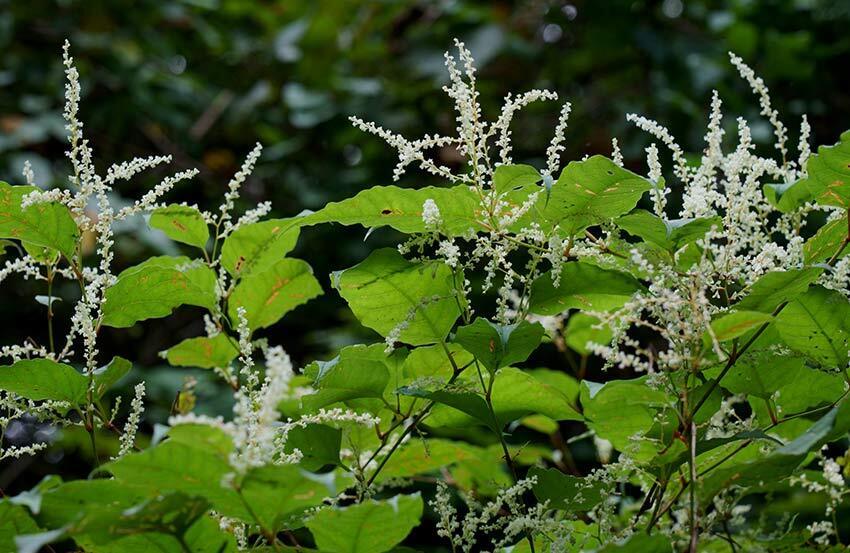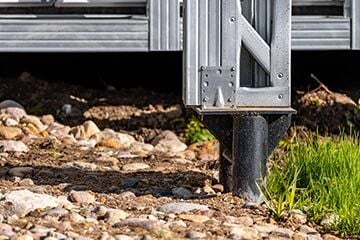There's not much that will strike more fear into homeowners than Japanese knotweed. After all, the fast-growing weed is estimated to cost the UK economy tens of millions of pounds a year.
It could derail mortgage applications, affect property values, and if it’s on your land, you’re legally obliged to control it.
Here’s what you need to know about the plant.

What is Japanese knotweed?
Japanese knotweed (fallopia japonica) is an invasive, non-native plant. As the name suggests, you'd be right in thinking it originally hails from Japan. It’s also native to other countries in East Asia, including China.
Sprouts tend to emerge from the ground in spring, and the plant flowers by late summer. The weed remains dormant in winter.
Due to its invasive nature, Japanese knotweed is legally classed as a controlled plant under the Wildlife and Countryside Act 1981. It's not illegal for the plant to exist on your property, but you would be committing an offence if you allow it to spread to another property.
So, how prominent is Japanese knotweed in the UK? Surprisingly, it's more common than you think.
Only 1 in 4 (26%*) UK homeowners or renters know what Japanese Knotweed is - yet nearly 1 in 5 (18%) are affected by the stubborn weed.
What does Japanese knotweed look like?
When Japanese knotweed emerges in the spring, it resembles asparagus tips sprouting from the ground – but pink.
Reddish-purple bamboo-like stems grow at a quick pace, up to 10cm a day in the summer months. You can identify the plants' appearance by their large leaves and cream flowers.
Japanese knotweed starts to create damage when its shoots exploit gaps and weaknesses in tough materials such as tarmac. It'll grow through any gap it can find, creating havoc in properties and structures it inhabits.
The weed typically reaches just over 2 metres in height but can reach up to 3 metres.
How to identify Japanese knotweed
It's not that straightforward to identify Japanese knotweed. That's because it's often confused with other plants such as Himalayan balsam and giant hogweed. Knowing key differences between these plants can help you correctly identify Japanese knotweed.
Each has pretty distinctive leaves, and that’s the easiest way to tell them apart. We're not all gardeners or horticulture experts after all! To nail down that you're dealing with Japanese knotweed, look for differences, such as:
- Japanese knotweed has spade-shaped leaves with a point at the end – so they’re quite broad.
- Himalayan balsam has much narrower, pointy leaves.
- Giant hogweed’s leaves are narrow with spikes all the way down, a little like nettles.
Japanese knotweed damage
Japanese knotweed can do extensive damage if left untreated. While it can’t grow through bricks and concrete, it can work its way through small cracks and gaps. So, it's not for the faint-hearted.
It can cause damage to foundations, patios, walls and more if ignored. This is why mortgage lenders take it seriously. It could also damage your bank balance tackling an extensive Japanese knotweed issue.
'Is it a problem where I live?'
If you're in doubt whether Japanese knotweed is a common problem in your area, you can search the UK heatmap.
How bad is Japanese knotweed?
It has the potential to cause huge problems. It grows rapidly, and by the time you’ve spotted it, it might've already established itself on your property.
But it's the devil you don't see that can cause the greatest degree of damage. Japanese knotweed can grow up to 3 metres tall, but it can also dive 3 metres beneath the ground, creating a stubborn root network underground.
If the plant exists within your property’s boundaries, it’s your duty to control it. That's why it can be a challenge for homeowners with Japanese knotweed on their property to sell at a later date. There's even the lingering possibility of prosecution if the plant within your boundary spreads to neighbouring properties.
It's something to bear in mind if you've been affected. Confused.com found that 41%* of Japanese Knotweed damages have happened to a neighbour's property or garden - where the plant didn’t originate.
If you allow the spread of Japanese knotweed into the wild – and it does spread easily – you could be fined or imprisoned.
If it’s outside your property boundaries, call your local council to see if they can eradicate it.
How can I get rid of Japanese knotweed?
Proceed with caution. After properly identifying the plant and understanding the risks posed, next on the agenda for homeowners is looking at how to kill Japanese knotweed.
It’s not easy, it takes time, and it could be expensive.
Removing Japanese knotweed yourself
While it’s possible to remove it yourself, we recommend hiring a professional to do it – especially if you want it to stay gone.
But if you’re going to do it yourself, you'll need stern determination and patience.
First, here’s some kit you need:
- Some overalls
- A visor or face shield
- Face mask (to P3 standards)
- Disposable shoe/boot covers
- Glyphosate weed killer
- A knapsack-style sprayer
- Some rubber gloves.
We also recommend researching the DIY removal process, as you have to be diligent.
Here are a few tips to keep in mind if you’re thinking of removing it yourself:
- It could take 3-5 years to completely remove it.
- Don’t put any part of the knotweed plant, dead or alive, in your compost or normal waste.
- It must be disposed of in a licensed waste disposal centre (including the dug-up soil), and only registered waste carriers can transport it.
If you're going to dispose of it yourself, call the Environment Agency first. For example, if you're planning on burning it, they need at least 1 week's notice.
What is the cost of removing Japanese knotweed if I hire someone to do it?
It’s expensive. You can expect to pay roughly £1,500-£2,000 to remove Japanese knotweed from your property. The overall cost depends on how big the job is and the provider you choose.
But despite the cost, this is the most recommended method for effective removal. You need to ensure professionals you hire have the right insurance and guarantees that go alongside their work.
It can also work out cheaper if you go with a professional. According to Confused.com data, DIY removal attempts cost UK homeowners or renters an average of £1,910*. In comparison, those who used professional help paid slightly less on average at £1,814.
Treating the plant chemically is one of the cheaper options, whereas having the area excavated to remove all rhizomes tends to be pricier.
The specialist you appoint should explain your options and recommend the best one for you. We recommend you get at least 3 quotes.
How does Japanese knotweed spread?
It spreads via what are known as the rhizomes. These are underground stems that can spread 3 metres deep and 7 metres wide. Japanese knotweed grows through most materials, other than concrete and brick.
If there are any cracks in foundations, it can grow through them. It might also take advantage of weaknesses in underground pipes and compromise them, too.
It’s a hardy plant that thrives in difficult circumstances. Stubbornness personified.
Is Japanese knotweed dangerous to humans?
No. It’s not toxic to humans. However, it is a danger to local habitats. Here's the crazy part: if a small fragment of it escapes on your clothing and is deposited elsewhere, there’s a chance it’ll grow there, too.
That's why handling it can be dangerous, as it could lead to further destruction.
How does Japanese knotweed affect my mortgage?
If you already have a mortgage and have noticed Japanese knotweed starting to grow, your home loan shouldn’t be affected. But you'll still have a duty to prevent it from encroaching onto neighbouring properties.
If you’re seeking a new mortgage, your options are more limited. Some providers might decline, while others might want a survey done and evidence of a treatment or removal plan.
The survey should most likely be by a Property Care Association (PCA) approved surveyor. Lenders are likely to want the removal specialist to be PCA-approved, too.
They might want to know how close it is in metres to the property. If it’s closer than 7 metres, they’ll likely want it removed by an approved specialist.
Sellers of an affected property might need to provide details on a TA6 form for their buyers too.
Is Japanese knotweed insurance included as part of my home cover?
It depends. This is where things can get murky, so stick with us.
Whether your home insurance can cover the cost of repairs arising from Japanese knotweed damage largely depends on your attempts to fix the issue. If you recognise the presence of the plant on your property, but make no effort to tackle the issue, any potential claim could be rejected.
Of the UK homeowners or renters who have been affected by Japanese knotweed, just over half (56%*) were able to claim on their insurance. Payouts average £3,027, underlining just how expensive the issue can be to resolve.
If you’re asked about the presence of Japanese knotweed when you buy home insurance, it’s important to be honest. Otherwise, you risk future claims being rejected, even if they're unrelated to the plant.
If Japanese knotweed originates from within your property's boundary, you'll be responsible for any damage it causes to neighbouring properties. If you have legal expenses cover as part of your home insurance, you might be able to use that to get legal advice.
What happens if I have Japanese knotweed in my house?
You should take action straightaway. It’s not a problem that will go away. Far from it, in fact.
It can grow quickly, so delaying the start of any treatment only makes it a bigger job – and a more expensive one, too. So, no extra motivation needed.
One of the more important points is that you're under no legal obligation to remove it from your property or your land. You are obliged to prevent it from spreading to any neighbouring land. The longer you leave it untreated, the more chance there is of it affecting your neighbours. So that’s another reason to make immediate plans to tackle the problem.
What is the situation with selling a house with Japanese knotweed?
There’s no law against selling a property that has Japanese knotweed, but you shouldn’t attempt to hide its existence from prospective buyers. Its existence can have implications from a buying and selling standpoint.
Research carried out on behalf of Confused.com asked 2,500 UK homeowners or renters about their experiences and opinions of Japanese knotweed. Over half (51%*) of respondents say the presence of the plant would put them off buying a property. Whereas more than 2 in 5 (43%) of those affected said it slowed down the mortgage or sale of their home.
If you fill out a TA6 form during the sale, you open yourself up to being the target of legal action if you lie. You can’t claim you didn’t know to mention the existence of Japanese knotweed, because a TA6 form has a dedicated section on it.
Let’s say you genuinely didn’t know there was Japanese knotweed on the property, and the buyer paid for a HomeBuyer report that missed its existence. The buyer might have legal recourse against the surveyor instead of you.
Assuming the Japanese knotweed is known and you’ve passed that information on, any buyer might expect the price of the purchase to reflect the fact that work to remove the weed is needed.
*Confused.com data July 2025







